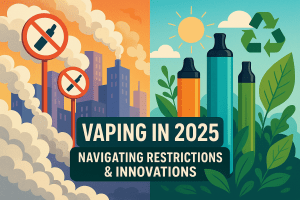Vaping has emerged as a popular alternative to traditional smoking, often marketed as a safer option. However, there are numerous myths and misconceptions surrounding its use. This article delves into the health impacts of vaping, focusing on its effects on the lungs, teenagers, and the reproductive system of adults.
Vaping and Health: Unraveling the Myths
The Perceived Safety of Vaping
Many believe that vaping is a harmless activity, primarily because it is marketed as a safer alternative to smoking cigarettes. While it is true that vaping eliminates the tar and many harmful chemicals found in traditional cigarettes, it is not without risks. E-cigarettes contain nicotine, flavorings, and other chemicals that can have detrimental health effects.
Chemical Exposure and Its Consequences
Vaping devices heat liquid into an aerosol that users inhale into their lungs. This liquid often contains nicotine, propylene glycol, glycerin, flavorings, and other additives. Some of these chemicals, particularly when heated, can produce harmful substances like formaldehyde and acetaldehyde, which are known carcinogens. Moreover, the long-term health effects of inhaling these chemicals are still not fully understood.
Impact on the Lungs
Short-Term Effects
Vaping can cause immediate irritation to the lungs and airways. Users often report symptoms such as coughing, wheezing, and shortness of breath. This irritation can lead to a condition known as “vaper’s cough,” a persistent dry cough that many vapers experience.
Long-Term Lung Health
Emerging research suggests that long-term vaping can lead to chronic lung conditions. Studies have found that vaping can cause inflammation and damage to lung tissue, potentially leading to chronic obstructive pulmonary disease (COPD) and other respiratory illnesses. Additionally, there have been reports of severe lung injuries linked to vaping, including cases of “popcorn lung,” a condition caused by inhaling diacetyl, a chemical used in some flavorings.
Vaping and Teenagers: A Growing Concern
The Rise of Teen Vaping
Vaping has seen a dramatic increase in popularity among teenagers. According to the Centers for Disease Control and Prevention (CDC), e-cigarette use among middle and high school students has surged in recent years. This rise is attributed to targeted marketing, appealing flavors, and the perception that vaping is a safe activity.
Health Risks for Teenagers
Teenagers are particularly vulnerable to the harmful effects of vaping. Nicotine exposure during adolescence can disrupt brain development, leading to cognitive and behavioral issues. Furthermore, teenagers who vape are more likely to transition to smoking traditional cigarettes, increasing their risk of long-term health problems.
Social and Psychological Impacts
In addition to physical health risks, vaping can have significant social and psychological effects on teenagers. The addictive nature of nicotine can lead to dependence, affecting academic performance and social interactions. Moreover, the normalization of vaping among peers can create pressure to engage in this risky behavior.
Effects on the Reproductive System of Adults
Male Reproductive Health
Nicotine and other chemicals found in e-cigarettes can adversely affect male reproductive health. Studies have shown that nicotine can reduce sperm quality and count, leading to potential fertility issues. Additionally, the oxidative stress caused by vaping can damage sperm DNA, affecting reproductive outcomes.
Female Reproductive Health
Vaping can also have negative effects on female reproductive health. Nicotine exposure has been linked to disruptions in the menstrual cycle and reduced fertility. Pregnant women who vape are at risk of complications such as preterm birth, low birth weight, and developmental issues in their offspring.
Long-Term Reproductive Consequences
The long-term consequences of vaping on reproductive health are still being studied. However, the potential for lasting damage is significant, given the known effects of nicotine and other chemicals on the reproductive system.
The Need for Awareness and Regulation
While vaping is often touted as a safer alternative to smoking, the health risks associated with it are substantial and multifaceted. From lung damage to negative impacts on teenagers and reproductive health, the consequences of vaping cannot be ignored. It is crucial for individuals, especially teenagers, to be aware of these risks and for stronger regulations to be implemented to curb the growing vaping epidemic.
Public health campaigns and educational initiatives are essential to dispel the myths surrounding vaping and to protect the health of current and future generations. By understanding the true impact of vaping, we can make informed decisions and promote healthier lifestyles.




